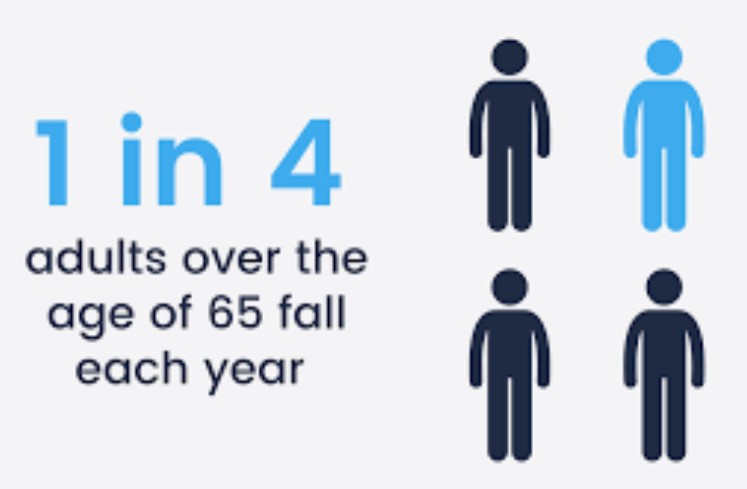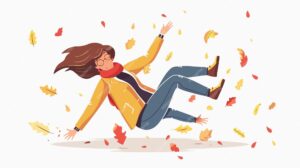
While falls can occur at any time of the year, research suggests that certain seasons pose more significant risks for older adults. In general, people tend to fall most often during the winter season, primarily due to slippery surfaces from snow and ice, which increases the risk of slipping and falling. We know as we age our bodies undergo various changes that can impact on our overall health and well-being. One of the most common concerns for the older generation is the increased risk of falls, leading to severe injuries and a loss of independence.
One out of four people over 65 falls every year, and less than half of them tell their doctor. Each year about one million hospitalizations in the elderly occur that are related to falls. Falling just once increases the risk of falling again. The risk of falling may increase related to many underlying conditions such as generalized weakness, foot problems, poor vision or balance, confusion, and pain. Our sense of balance is in our inner ear. People who have hearing loss are more likely to experience balance problems. 1
Unsafe home or work environments, such as poor lighting and clutter, can increase the risk of falls. It is important for someone who has fallen to be evaluated after a fall to identify and treat injuries. Falls can result in broken bones, hip fractures, and head injuries. Identifying the circumstances of the fall assists in implementing appropriate preventative measures. 2
Some medications increase the risk of falling especially in older individuals. In fact, many medications may increase the risk of falling especially in older individuals. It is important that you review a list of all your medications with your health care provider, including all over-the-counter medications and nutritional supplements as well as all prescribed medications. This medication review should include the side effects of medications that may increase fall risk. Some common medications, such as sedatives, antihistamines, and some antidepressants may affect thinking or cause fatigue and increase fall risk. 2
There are many things we can do to reduce our risk of falling. As we age, we should have our vision and hearing evaluated regularly. Declining hearing and vision as we age are risk factors for falls. Uncluttered home and work environments and bright lights can reduce the risk of falling. Coffee tables may be a fall risk factor if placed in a busy place in the home. Assure that there are night lights in bedrooms, bathrooms and hallways, and readily available flashlights available in case of a power outage. Rugs are another potential household hazard. Scatter rugs may be one of the worst risk factors for falls in the home. Rugs should be secured to the floor by tape or other means or be removed from the house. 2,3,4
Safe footwear and exercise are important preventive measures. Safe shoes should have flat or low heels to assure balance and stability, and should fit securely and comfortably to the foot. Regular exercise reduces fall risk by improving strength, balance, coordination and stability.5
It’s alarming that more than one in 4 elders over 65 years of age may experience a fall and yet less than half of them report this to a doctor or family member. They may be reluctant to tell family members or caregivers of a fall for fear of losing their independence. The bottom-line is that elders who have fallen once are at the risk of falling again. Most importantly, the fall may just be a symptom or consequence of a larger condition. So, ignoring the fall means, the underlying condition may not be addressed in time. This can be risky to the elder, in the long run.
Most of us know someone who has experienced a fall, or we have fallen ourselves. Falls are the leading cause of fatal and nonfatal injuries for older Americans. But through practical lifestyle adjustments, evidence-based falls prevention programs, and clinical-community partnerships, the number of falls among older adults can be substantially reduced.
Like with any other health condition, even when it comes to falls, “an ounce of prevention is worth a pound of cure” (Benjamin Franklin, 1735).
References
-
http://www.cdc.gov/falls/data-research/facts-stats/index.html
-
https://www.mayoclinic.org/healthy-lifestyle/healthy-aging/in-depth/fall-prevention/art-20047358
-
https://www.ncbi.nlm.nih.gov/pmc/articles/PMC3591732/
-
https://www.ncbi.nlm.nih.gov/books/NBK279394/
-
https://www.cdc.gov/steadi/media/pdfs/2024/08/STEADI_Feet_Footwear_Guide_O.pdf
For more information:
-
Geriatric winter falls: When a simple bump on the ice can be serious: https://www.mayoclinic.org/medical-professionals/trauma/news/geriatric-winter-falls-when-a-simple-bump-on-the-ice-can-be-serious/mac-20451017#:~:text=Older%20adults%20are%20more%20likely,Clinic’s%20campus%20in%20Rochester%2C%20Minnesota.
-
CDC: Facts About Falls: https://www.cdc.gov/falls/data-research/facts-stats/index.html
-
Get the Facts on Falls Prevention: https://www.ncoa.org/article/get-the-facts-on-falls-prevention/
-
The Impact of Weather and Seasons on Falls and Physical Activity among Older Adults with Glaucoma: A Longitudinal Prospective Cohort Study: https://www.ncbi.nlm.nih.gov/pmc/articles/PMC8156454/

